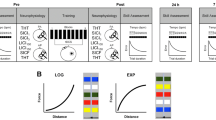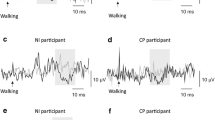Abstract
Training-induced changes in cortical excitability may play an important role in rehabilitation of gait ability in patients with neurological disorders. In this study, we investigated the effect of a 32-min period of motor skill, non-skill and passive training involving the ankle muscles on leg motor cortical excitability in healthy humans. Transcranial magnetic stimulation (TMS) at a range of intensities was applied to obtain a recruitment curve of the motor evoked potentials (MEPs) in the tibialis anterior (TA) muscle before and after training. We also explored the effect of training on inhibitory and facilitatory cortical circuits by using a paired-pulse TMS technique at intervals of 2.5 ms (short-interval intracortical inhibition, SICI) and 8 ms (intracortical facilitation, ICF). During motor skill training, subjects were instructed to make a cursor follow a series of target lines on a computer screen by performing voluntary ankle dorsi- and plantarflexion movements. Non-skill and passive training consisted of repeated voluntary and assisted dorsi- and plantarflexion movements, respectively. Recruitment curves increased significantly after 32 min of motor skill training but not after non-skill and passive training, suggesting that only skill motor training increases motor cortical excitability. Motor skill training was not accompanied by any changes in the recruitment curves of TA MEPs evoked by transcranial electrical stimulation, suggesting that the increased MEPs to TMS was likely caused by changes in excitability at a cortical site. SICI was decreased after 32 min of motor skill training but no changes were observed in ICF. We conclude that similar plastic changes as have previously been reported for the hand motor following motor skill training may also be observed for the leg motor area. The observed plastic changes appeared to be related to the degree of difficulty in the motor task, and may be of relevance for rehabilitation of gait disorders.





Similar content being viewed by others
References
Armstrong DM (1988) The supraspinal control of mammalian locomotion. J Physiol 405:1–37
Brouwer B, Ashby P (1990) Corticospinal projections to upper and lower limb spinal motoneurons in man. Electroencephalogr Clin Neurophysiol 76:509–519
Burke D, Hicks R, Gandevia SC, Stephen J, Woodforth I, Crawford M (1993) Direct comparison of corticospinal volleys in human subjects to transcranial magnetic and electrical stimulation. J Physiol 470:383–393. Erratum in: J Physiol (Lond) 1994 476:553
Burridge JH, Wood DE, Taylor PN, McLellan DL (2001) Indices to describe different muscle activation patterns, identified during treadmill walking, in people with spastic drop-foot. Med Eng Phys 23:427–434
Butefisch CM, Davis BC, Wise SP, Sawaki L, Kopylev L, Classen J, Cohen LG (2000) Mechanisms of use-dependent plasticity in the human motor cortex. Proc Natl Acad Sci USA 97:3661–3665
Capaday C, Lavoie BA, Barbeau H, Schneider C, Bonnard M (1999) Studies on the corticospinal control of human walking. I. Responses to focal transcranial magnetic stimulation of the motor cortex. J Neurophysiol 81:129–139
Classen J, Liepert J, Wise SP, Hallett M, Cohen LG (1998) Rapid plasticity of human cortical movement representation induced by practice. J Neurophysiol 79:1117–1123
Classen J, Liepert J, Hallett M, Cohen L (1999) Plasticity of movement representation in the human motor cortex. Electroencephalogr Clin Neurophysiol Suppl 51:162–173
Day BL, Dressler D, Maertens de Noordhout A, Marsden CD, Nakashima K, Rothwell JC, Thompson PD (1989) Electric and magnetic stimulation of human motor cortex: surface EMG and single motor unit responses. J Physiol 412:449–73. Erratum in: J Physiol (Lond) 1990 430:617
Di Lazzaro V, Oliviero A, Profice P, Meglio M, Cioni B, Tonali P, Rothwell JC (2001) Descending spinal cord volleys evoked by transcranial magnetic and electrical stimulation of the motor cortex leg area in conscious humans. J Physiol 537:1047–1058
Drew T, Jiang W, Widajewicz W (2002) Contributions of the motor cortex to the control of the hindlimbs during locomotion in the cat. Brain Res Brain Res Rev 40:178–191
Elbert T, Pantev C, Wienbruch C, Rockstroh B, Taub E (1995) Increased cortical representation of the fingers of the left hand in string players. Science 270:305–307
Fisher RJ, Nakamura Y, Bestmann S, Rothwell JC, Bostock H (2002) Two phases of intracortical inhibition revealed by transcranial magnetic threshold tracking. Exp Brain Res 143:240–248
Hoffman DS, Strick PL (1995) Effects of a primary motor cortex lesion on step-tracking movements of the wrist. J Neurophysiol 73:891–895
Hund-Georgiadis M, von Cramon DY (1999) Motor-learning-related changes in piano players and non-musicians revealed by functional magnetic-resonance signals. Exp Brain Res 125:417–425
Iles JF, Cummings R (1992) Electrical and magnetic stimulation of motor cortex in humans. J Physiol 452:287P
Jacobs KM, Donoghue JP (1991) Reshaping the cortical motor map by unmasking latent intracortical connections. Science 251:944–947
Jankowska E, Padel Y, Tanaka R (1975) Projections of pyramidal tract cells to alpha-motoneurones innervating hind-limb muscles in the monkey. J Physiol 249:637–667
Karni A, Meyer G, Jezzard P, Adams MM, Turner R, Ungerleider LG (1995) Functional MRI evidence for adult motor cortex plasticity during motor skill learning. Nature 377:155–158
Kleim JA, Lussnig E, Schwarz ER, Comery TA, Greenough WT (1996) Synaptogenesis and Fos expression in the motor cortex of the adult rat after motor skill learning. J Neurosci 16:4529–4535
Kleim JA, Barbay S, Nudo RJ (1998) Functional reorganization of the rat motor cortex following motor skill learning. J Neurophysiol 80:3321–3325
Kleim JA, Barbay S, Cooper NR, Hogg TM, Reidel CN, Remple MS, Nudo RJ (2002) Motor learning-dependent synaptogenesis is localized to functionally reorganized motor cortex. Neurobiol Learn Mem 77:63–77
Kujirai T, Caramia MD, Rothwell JC, Day BL, Thompson PD, Ferbert A, Wroe S, Asselman P, Marsden CD (1993) Corticocortical inhibition in human motor cortex. J Physiol 471:501–519
Lech M, Skibinska A, Kossut M (2001) Delayed upregulation of GABA(A) alpha1 receptor subunit mRNA in somatosensory cortex of mice following learning-dependent plasticity of cortical representations. Brain Res Mol Brain Res 96:82–86
Liepert J, Classen J, Cohen LG, Hallett M (1998) Task-dependent changes of intracortical inhibition. Exp Brain Res 118:421–426
Lotze M, Braun C, Birbaumer N, Anders S, Cohen LG (2003) Motor learning elicited by voluntary drive. Brain 126:866–872
Nielsen JB (2002) Motoneuronal drive during human walking. Brain Res Rev 40:192–201
Nielsen J, Petersen N, Deuschl G, Ballegaard M (1993) Task-related changes in the effect of magnetic brain stimulation on spinal neurones in man. J Physiol 471:223–243
Nielsen J, Petersen N, Ballegaard M (1995) Latency of effects evoked by electrical and magnetic brain stimulation in lower limb motoneurones in man. J Physiol 484:791–802
Nordstrom MA, Butler SL (2002) Reduced intracortical inhibition and facilitation of corticospinal neurons in musicians. Exp Brain Res 144:336–342
Nudo RJ (2003) Functional and structural plasticity in motor cortex: implications for stroke recovery. Phys Med Rehabil Clin N Am 14:57–76
Nudo RJ, Milliken GW, Jenkins WM, Merzenich MM (1996) Use-dependent alterations of movement representations in primary motor cortex of adult squirrel monkeys. J Neurosci 16:785–807
Pascual-Leone A, Grafman J, Hallett M (1994) Modulation of cortical motor output maps during development of implicit and explicit knowledge. Science 263:1287–1289
Pascual-Leone A, Nguyet D, Cohen LG, Brasil-Neto JP, Cammarota A, Hallett M (1995) Modulation of muscle responses evoked by transcranial magnetic stimulation during the acquisition of new fine motor skills. J Neurophysiol 74:1037–1045
Paz R, Boraud T, Natan C, Bergman H, Vaadia E (2003) Preparatory activity in motor cortex reflects learning of local visuomotor skills. Nat Neurosci 6:882–890
Petersen N, Christensen LO, Nielsen J (1998) The effect of transcranial magnetic stimulation on the soleus H reflex during human walking. J Physiol 513:599–610
Petersen NT, Butler JE, Marchand-Pauvert V, Fisher R, Ledebt A, Pyndt HS, Hansen NL, Nielsen JB (2001) Suppression of EMG activity by transcranial magnetic stimulation in human subjects during walking. J Physiol 537:651–656
Petersen NT, Pyndt HS, Nielsen JB (2003) Investigating human motor control by transcranial magnetic stimulation. Exp Brain Res 152:1–16
Priori A, Bertolasi L, Dressler D, Rothwell JC, Day BL, Thompson PD, Marsden CD (1993) Transcranial electric and magnetic stimulation of the leg area of the human motor cortex: single motor unit and surface EMG responses in the tibialis anterior muscle. Electroencephalogr Clin Neurophysiol 89:131–137
Remple MS, Bruneau RM, VandenBerg PM, Goertzen C, Kleim JA (2001) Sensitivity of cortical movement representations to motor experience: evidence that skill learning but not strength training induces cortical reorganization. Behav Brain Res 123:133–141
Ridding MC, Rothwell JC (1997) Stimulus/response curves as a method of measuring motor cortical excitability in man. Electroencephalogr Clin Neurophysiol 105:340–344
Roche RA, O’Mara SM (2003) Behavioural and electrophysiological correlates of visuomotor learning during a visual search task. Brain Res Cogn Brain Res 15:127–136
Rossini PM, Barker AT, Berardelli A, Caramia MD, Caruso G, Cracco RQ, Dimitrijevic MR, Hallett M, Katayama Y, Lucking CH, et al (1994) Non-invasive electrical and magnetic stimulation of the brain, spinal cord and roots: basic principles and procedures for routine clinical application. Report of an IFCN committee. Electroencephalogr Clin Neurophysiol 91:79–92
Rothwell JC (1991) Physiological studies of electric and magnetic stimulation of the human brain. Electroencephalogr Clin Neurophysiol 43:29–35
Schubert M, Curt A, Jensen L, Dietz V (1997) Corticospinal input in human gait: modulation of magnetically evoked motor responses. Exp Brain Res 115:234–246
Tinazzi M, Farina S, Tamburin S, Facchini S, Fiaschi A, Restivo D, Berardelli A (2003) Task-dependent modulation of excitatory and inhibitory functions within the human primary motor cortex. Exp Brain Res 150:222–229
Toner LV, Cook K, Elder GC (1998) Improved ankle function in children with cerebral palsy after computer-assisted motor learning. Dev Med Child Neurol 40:829–835
Uy J, Ridding MC, Hillier S, Thompson PD, Miles TS (2003) Does induction of plastic change in motor cortex improve leg function after stroke? Neurology 61:982–984
VandenBerg PM, Hogg TM, Kleim JA, Whishaw IQ (2002) Long-Evans rats have a larger cortical topographic representation of movement than Fischer-344 rats: a microstimulation study of motor cortex in naive and skilled reaching-trained rats. Brain Res Bull 59:197–203
Winter DA, Bishop PJ (1992) Lower extremity injury. Biomechanical factors associated with chronic injury to the lower extremity. Sports Med 14:149–156
Ziemann U, Rothwell JC, Ridding MC (1996) Interaction between intracortical inhibition and facilitation in human motor cortex. J Physiol 496:873–881
Acknowledgements
The authors are very grateful to Torill Bjugan, Dinah Merklin and Lene Østerby for their help during this study. This work was supported by grants from the Danish Health Research Council, The Danish Society of Multiple Sclerosis, The Novo Nordisk Foundation and The Danish Ministry of Culture.
Author information
Authors and Affiliations
Corresponding author
Rights and permissions
About this article
Cite this article
Perez, M.A., Lungholt, B.K.S., Nyborg, K. et al. Motor skill training induces changes in the excitability of the leg cortical area in healthy humans. Exp Brain Res 159, 197–205 (2004). https://doi.org/10.1007/s00221-004-1947-5
Received:
Accepted:
Published:
Issue Date:
DOI: https://doi.org/10.1007/s00221-004-1947-5




